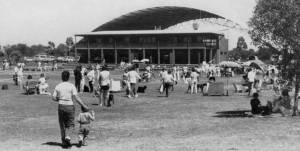Dogs West
 Grand Champion Field Spaniel 'Bonny Union Jack' born 1905
Grand Champion Field Spaniel 'Bonny Union Jack' born 1905
Before Federation in 1901, the huge Colony of Western Australia developed separately from the rest of Australia. At that time, if any dog shows were held, they were conducted in the south-west corner of the State. Until 1945, their only dog club in WA was the Western Australian Kennel Club (WAKC). This situation was different from that in the Colony of NSW where, at that time each State had several different controlling bodies or Kennel Clubs.
Uniquely, the (WAKC), enjoyed affiliation with the Kennel Club of England. This meant its Rules extended to granting titles beyond that of Champion. Consequently, the Field Spaniel pictured carried the prestigious title of Grand Commonwealth Champion. Apparently he accumulated the six Challenge Certificates necessary under the Kennel Club of England's rules for him to become a Grand Commonwealth Champion[4a]. This dog, Bonnie Union Jack was imported into WA in 1906 by Mr Ralph Potts[5].
History of DogsWest
The Royal Agricultural Society of WA, which had been holding Shows since the 1830s, probably hosted WA's earliest dog shows. Although records are difficult to find, the 1898 'West Australian' newspaper recorded that a particular Airedale Terrier that I had been researching had won a first prize at a Show[1]. Additionally, by1911, it was reported that 120 dogs competed in their 'Royal' Show[2]. This obviously preceded the WAKC becoming affiliated with the English Kennel Club' because records document that the WAKC was founded in 1912 and conducted its first Championship Show in 1914[4].
Affiliation with the English Kennel Club had at least two advantages over the dog clubs in the Colony of New South Wales. These were:
Because the English Kennel Club dealt with registrations, the issue of pedigrees as well as the rules for conducting dog shows, it effectively had a Stud Book.
- The WAKC was able to award Challenge Certificates for Best of Breed of sex mirroring the English system of gaining Championship titles[4]
The WA Royal Agricultural Society (RAS of WA)
Meanwhile, the RAS of WA, which had been holding Agricultural since at least 1834, probably also hosted WA's early dog shows. Although the year they included dogs remains unclear, by 1905 when the RAS of WA had moved to the Claremont Grounds in Perth where, by 1911, 120 dogs competed in their 'Royal' Show[2]. During his time, the RAS of WA also established Stud Books for breeds of cattle and sheep throughout the State.
Because of this experience in establishing Stud Books, in 1945 when there was an upsurge of interest in purebred dog activities, the WAKC put in place an arrangement for the RAS of WA to take over over the WACA's Secretarial duties for a fee. The WAKC became the Canine Association of WA (CAWA). In 1952, the CAWA was re-constituted with the right for either party to terminate after giving six months notice.
The CAWA grew in membership under this arrangement. The highlights were
- In 1961, they affiliated with the ANKC
- In 1962, the CAWA uniquely introduced an Associate category of membership to allow owners of de-sexed as well as dogs without a pedigree, to take part in Obedience events.
- In August, 1971, the WA Canine News commenced publication.
In 1980, following difficulties accruing with the authoritarianism of the Royal Agricultural Society of Western Australia (RAS), the Canine Association of Western Australia (CAWA) moved to sever all connections with the RAS. They moved from the office it had occupied in the RAS Showgrounds to rental accommodation in Stirling Highway in Nedlands. Dogs shows continued to be conducted at the RAS Showgrounds, utilising a pavilion constructed there by the CAWA but still part of the Showgrounds.
Dogs West finds a Home
In 1984 the CAWA broke all ties with the RAS of WA and moved to offices which had been constructed on land purchased by the CAWA in Warton Road, Southern River in the City of Gosnells. As an independent body, in 1988 WA linked their dog registrations to the NSW digital system. Today the controlling body for Western Australia is still the CAWA which trades as 'DogsWest'.
 Dog Showing Complex, WAWestern Australia is unique in that, just 16 km south of Perth, the capital city of WA, a 14-acre bush block was designated as a 'Kennel Zone'. It provided 25.3 km² where dog activities associated with breeding and boarding dogs could be conducted without a permit. In many built-up areas in the rest of Australia, a permit is required to keep more than two dogs. Additionally, in 1987 the CAWA built the wonderful administration complex and undercover dog showing area pictured.
Dog Showing Complex, WAWestern Australia is unique in that, just 16 km south of Perth, the capital city of WA, a 14-acre bush block was designated as a 'Kennel Zone'. It provided 25.3 km² where dog activities associated with breeding and boarding dogs could be conducted without a permit. In many built-up areas in the rest of Australia, a permit is required to keep more than two dogs. Additionally, in 1987 the CAWA built the wonderful administration complex and undercover dog showing area pictured.
References and Further Reading:
[1] Information supplied by Mr Wright, Albany WA from 'The West Australian' Thursday 12 May 1898
[2] Mr Piesse, President. RAS of WA 'A Century of Shows', Article published as Foreword in the 1934 Perth Royal Show Catalogue.
[4] 'An Historical Record of Australian Kennel Controls' published ANKC, Ascot Vale Vic 1988.
[4a] Ibid., Canine Association of Western Australia by Ann Mitchell page 133 - 141